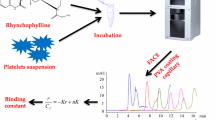Abstract
The frontal analysis continuous capillary electrophoresis (FACCE) technique was used for the characterziation of the interaction between lidocaine-HCl (Lido) and components of Na-hyaluronic acid (HA). N-Acetylglucosamine (GlcNAc) and glucuronic acid (GluA) were the components of Na-hyaluronic acid. For the investigations fused silica capillaries were used. The FACCE method was compared to affinity capillary electrophoresis (ACE). The association constants between lidocaine-HCl and the components of Na-hyaluronic acid were determined using FACCE. It was observed that only an interaction between Lido and GluA exhibited. The association constant (K lido-GluA) between Lido and GluA was 26 ± 0.3 L mol−1.




Similar content being viewed by others
References
Steinmeyer J (2001) Orthopadie 30:856–865. doi:10.1007/s001320170022
Hassan HG, Akerman B, Renck H, Lindberg B, Lindquist B (1985) Acta Anaesthesiol Scand 29:384–388. doi:10.1111/j.1399-6576.1985.tb02220.x
Doherty MM, Hughes PJ, Korszniak NV, Charman WN (1995) Anesth Analg 80:740–746. doi:10.1097/00000539-199504000-00016
Hartke K, Hartke H, Mutschler E, Rücker G, Wichtl M (2002) Kommentar zur Ph. Eur. NT, Wissenschaftliche Verlagsgesellschaft mbH Stuttgart, Govi-Verlag Eschborn, 15. Lfg., L 15/1
Neubert RHH, Hildebrand A, Janich M, Mrestani Y, Plätzer M (2000) Pharm Ztg 145:3691–3969
Alhabi M, Mrestani Y, Richter H, Neubert RHH (2000) Pharm Biomed Anal 29:550–560
Mrestani Y, Neubert RHH, Rüttinger HH (1998) J Chromatogr A 802:89–93. doi:10.1016/S0021-9673(97)01072-8
Guitjt-van Duijn RM, Frank J, van Dedem GWK (2000) Electrophoresis 21:3905–3918. doi:10.1002/1522-2683(200012)21:18<3905::AID-ELPS3905>3.0.CO;2-4
Gao JY, Dubin PL, Muhoberac BB (1997) Anal Chem 69:2645–2951
Raucher K, Voigt J, Wilke I, Wilke K-T (1977) Chemische Tabellen und Rechentafeln für die analytische Praxis. Deutscher Verlag für Grundstoffindustrie Leipzig
Thomae AV (1988) Charakterisierung von Wechselwirkungen zwischen Hyaluronsäure und Lidocainhydrochlorid. Diplomarbeit, Martin-Luther-Universität Halle-Wittenberg
Haas U (1988) Physik für Pharmazeuten und Mediziner. Wissenschaftliche Verlagsgesellschaft mbH Stuttgart, 5 Auflage 40–141
Bello MS, Rezzonico R, Righetti PG (1994) J Chromatogr A 659:199–204. doi:10.1016/0021-9673(94)85022-4
Ostergaard J, Heegaard NHH (2003) Electrophoresis 24:2903–2913. doi:10.1002/elps.200305526
Rundlett KL, Armstrong DW (1997) Electrophoresis 18:2194–2202. doi:10.1002/elps.1150181210
Author information
Authors and Affiliations
Corresponding author
Rights and permissions
About this article
Cite this article
Mrestani, Y., Hammitzch, M. & Neubert, R.H.H. Investigation of the Interaction Between Lidocaine and the Components of Hyaluronic Acid Using Frontal Analysis Continuous Capillary Electrophoresis. Chroma 69, 1321–1324 (2009). https://doi.org/10.1365/s10337-009-1075-2
Received:
Revised:
Accepted:
Published:
Issue Date:
DOI: https://doi.org/10.1365/s10337-009-1075-2




